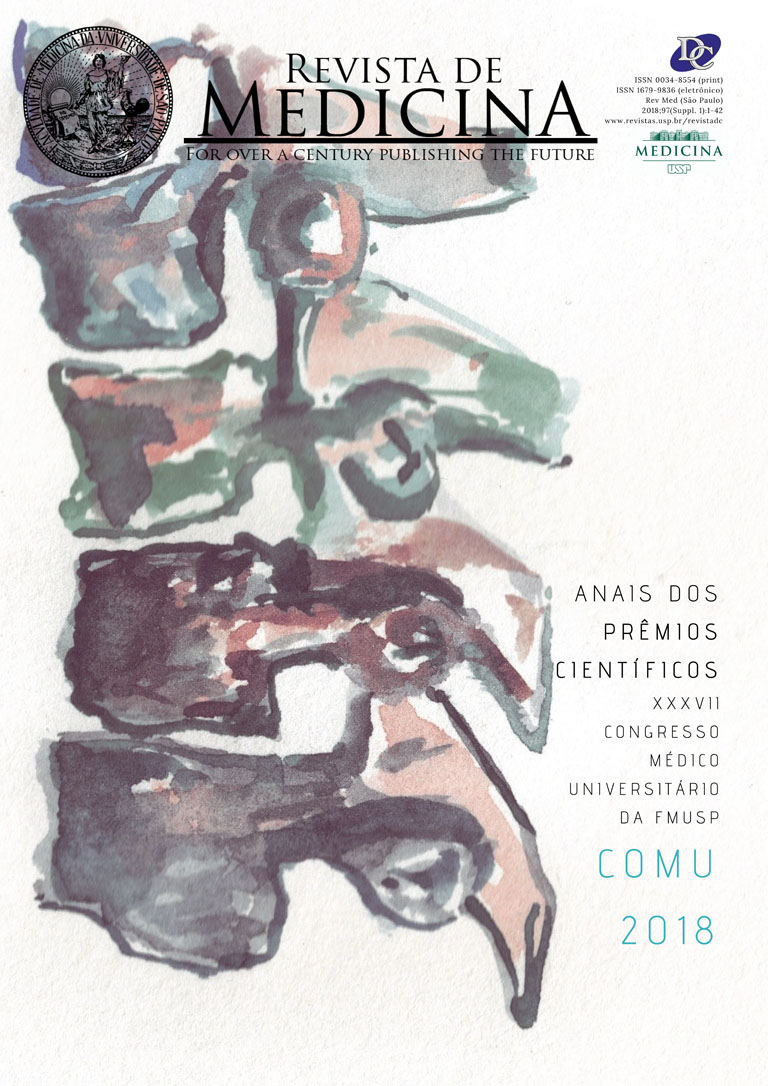Effects of sympathectomy on cardiac remodeling in a doxorrubicin-induced dilated cardiomyopathy model
DOI:
https://doi.org/10.11606/issn.1679-9836.v97iSuppl.1p32-33Palavras-chave:
Doxorrubicina, Transplante de Coração, Cardiomiopatias, SimpatectomiaResumo
Introduction: The main cause of cardiac transplantation is dilated cardiomyopathy (DCM), in which there are ventricular dilation and systolic dysfunction, leading to congestive heart failure. Ventricular remodeling involves activation of the sympathetic nervous and renin-angiotensin- aldosterone systems. As such, classic treatments include angiotensin-converting enzyme inhibitors (ACEI), beta-blockers and mineralocorticoid receptor antagonists. Once such treatments only delay the development of the disease, it is important to look for better therapeutic options. Experimental models demonstrated the benefits of sympathetic blockade on preserving ventricular function and preventing left ventricle remodeling after myocardial infarction. Objective: We evaluated the influence of bilateral thoracic sympathectomy on left ventricle remodeling and function in a rat model of doxorubicin induced DCM. Methodology: Animals were randomly divided into 4 groups of 7 rats each. DCM only, bilateral sympathectomy (BS) with DCM, ACEI with DCM and also a negative control group (SHAM). DCM was inducted in the experimental groups through weekly intraperitoneal injection of doxorubicin. Fifteen days after the beginning of DCM induction, bilateral sympathectomy was performed by chemical sclerosis of stellate ganglion with ethanol in the BS group. From this same time point until the end of experimental protocol, animals of the ACEI group received daily, through water ingestion, a enalapril maleate dilution. Ten weeks later, left ventricular function was evaluated with the use of a microtip pressureconductance catheter. Also, extracellular fibrosis were evaluated and BCL-2 expression on myocardial tissue were quantified. Partial Results: DCM group showed an increased left ventricular (LV) end-diastolic volume in relation to Sham group
(p=0.034). Also, a significant decrease was observed in LV ejection fraction in DCM group, while bilateral sympathectomy were able to preserve this parameter (p=0,001). Furthermore, both treated groups showed an increased LV stroke work compared to DCM group (p=0,002). Myocardial extracellular fibrosis were more present in control group, whereas both BS and ACE inhibitor treatments reduced the areas of fibrotic tissue (p<0,0001), which can be associated with increased expression of anti-apoptotic BCL-2 in treated groups (p=0,0004). Discussion and Conclusion: Sympathetic blockade was able to suppress myocardial tissue fibrosis, most likely due to increasing anti-apoptotic BCL-2 expression. Moreover, LV function was maintained as observed through LV ejection fraction,
stroke work and cardiac efficiency levels. Although ACE inhibitor was also able to inhibit extracellular fibrosis and increase BCL- 2 expression, cardiac function has not been preserved as in BS group. Therefore, we conclude that BS was able to decrease myocardial tissue deterioration and also to preserve LV in a doxorubicin model of DCM in rats.
Keywords: Sympathectomy; Cardiomyopathy; Cardiac transplantation; Doxorubicin.
Downloads
Downloads
Publicado
Edição
Seção
Licença
Copyright (c) 2018 Revista de Medicina (São Paulo)

Este trabalho está licenciado sob uma licença Creative Commons Attribution-ShareAlike 4.0 International License.




